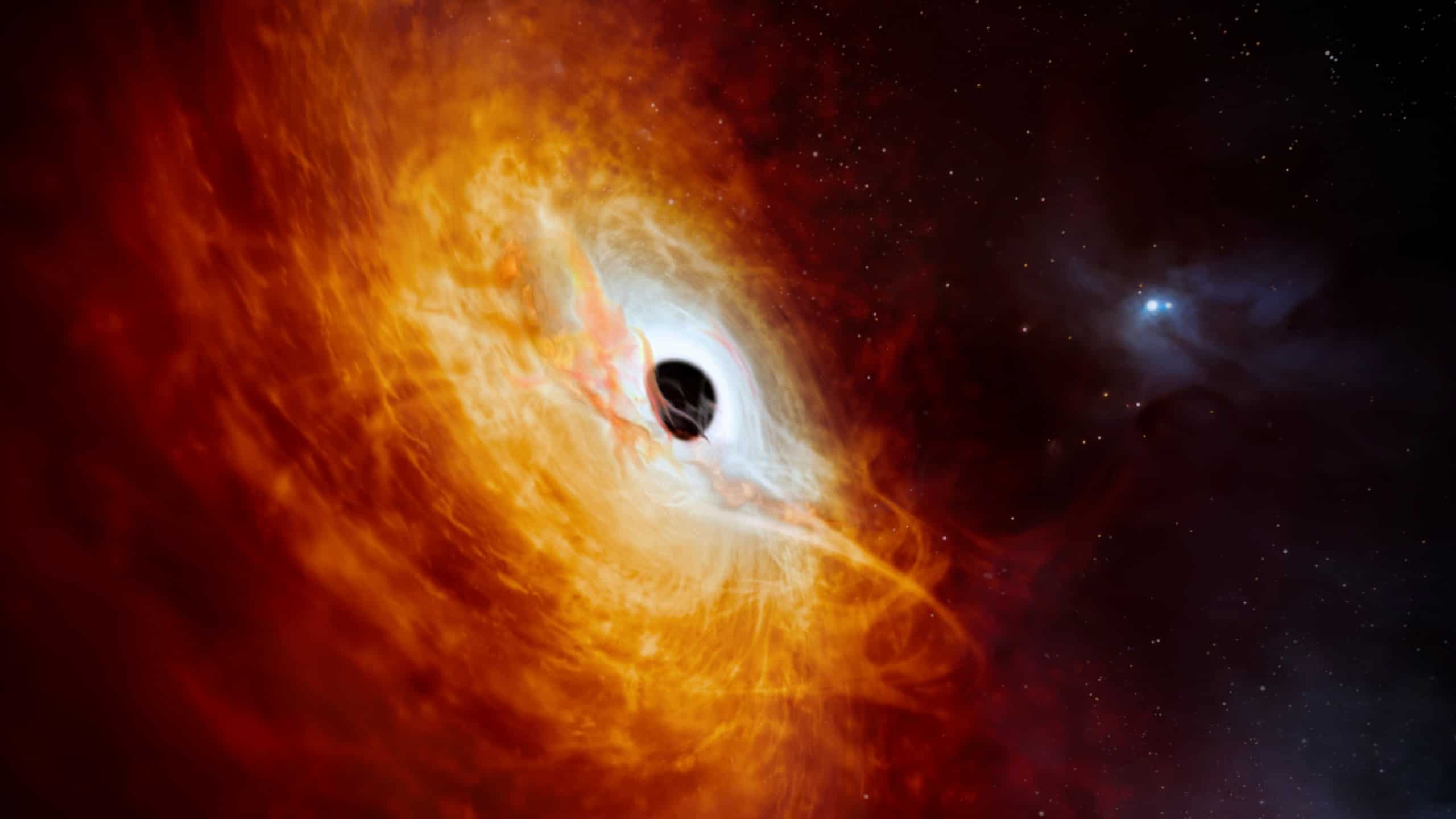A black hole is a region of spacetime where gravity is so strong that nothing, not even light, can escape from it, while a nebula is a vast cloud of gas and dust in space, often the birthplace of stars. Black holes are known for their immense gravitational pull, which can result from a dying star collapsing under its own weight.
Nebulas, on the other hand, are typically formed by the remnants of a dying star, where new stars are born. Both black holes and nebulas play crucial roles in the formation and evolution of galaxies. Join us as we delve deeper into the fascinating world of these cosmic phenomena and explore their unique characteristics and mysteries.
The Basics Of Black Holes And Nebulas
Black holes and nebulae are fascinating astronomical phenomena that captivate the imagination. While black holes are characterized by their intense gravitational pull, nebulae showcase the beauty of interstellar gas and dust. Understanding the distinctions between the two offers a glimpse into the wonders of the universe.
Defining Black Holes
Black holes are mysterious entities that capture the imagination of scientists and space enthusiasts alike. They are characterized by their immense gravitational pull, which is so strong that nothing, not even light, can escape their grasp. Essentially, a black hole is a region in space where matter has collapsed under its own weight, creating a gravitational field so intense that it creates a singularity – an infinitely dense point. This concept may sound far-fetched, but black holes are backed by strong evidence and widely accepted in the scientific community.
Defining Nebulas
Nebulas, on the other hand, are beautiful and awe-inspiring formations in space. They are vast clouds of gas and dust, strewn across the universe. Nebulas come in a variety of shapes and colors, each with its unique characteristics. These celestial clouds are often the birthplaces of stars, where gravity pulls the gas and dust together to form new stellar systems. Nebulas can also provide invaluable insight into the life cycle of stars, giving astronomers a glimpse into the processes that shape the universe.
While black holes and nebulas may seem distinct in their nature, they share a crucial role in the cosmos. Both black holes and nebulas have contributed to our understanding of the universe and have captivated scientists and stargazers for centuries. Exploring the depths of space and unraveling the mysteries of these cosmic phenomena is an ongoing endeavor that continues to push the boundaries of human knowledge.

Credit: pune.news
Formation And Characteristics
Diving into the cosmos, black holes are known for their intense gravitational pull, while nebulae showcase colorful beauty in deep space. Each formation captures contrasting characteristics, with black holes shrouded in mystery and nebulae radiating ethereal allure. Both cosmic wonders offer a captivating glimpse into the limitless expanse of the universe.
How Black Holes Form
Black holes are fascinating cosmic phenomena that have puzzled scientists for decades. They form when a massive star collapses under its own gravitational pull. The core of the star collapses to an infinitely small point called a singularity, surrounded by a boundary known as the event horizon. Anything that crosses the event horizon gets trapped by the black hole’s immense gravity and can never escape. As the singularity becomes denser and the event horizon grows larger, the black hole gains more mass and gravitational pull.Types Of Nebulas
Nebulas, on the other hand, are vast clouds of gas and dust that exist in outer space. These celestial formations can vary in size, ranging from just a few light-years across to hundreds of light-years or more. There are several types of nebulae, including emission nebulae, reflection nebulae, and planetary nebulae. Emission nebulae are made up of ionized gas that emits light of various wavelengths. Reflection nebulae, on the other hand, do not emit their own light but instead reflect the light of nearby stars. Planetary nebulae are formed when a dying star expels its outer layers into space, creating a beautiful and often symmetrical nebula. When we look at the formation and characteristics of black holes and nebulae, we can see the immense contrast between these two cosmic wonders. While black holes are formed through the collapse of massive stars and possess an unfathomable gravitational pull, nebulae are formed through the accumulation of gas and dust, often showcasing their beauty in vibrant colors and intricate patterns. Whether we are marveling at the mysterious depths of a black hole or the ethereal glow of a nebula, these celestial objects continue to captivate our imagination, reminding us of the vastness and beauty of our universe.Physical Properties
Explore the contrasting physical properties of black holes and nebulae in space. Black holes possess immense gravitational pull, while nebulae are vast clouds of gas and dust. Understanding these differences sheds light on the mysteries of the universe.
Physical Properties Black holes and nebulas are two fascinating objects in the universe, each with unique physical properties. Understanding these properties can give us insight into the nature of these celestial phenomena. Gravity and Singularity Black holes are known for their intense gravitational pull, which is so strong that not even light can escape from their clutches. At the center of a black hole lies a point of infinite density called a singularity. Gas and Dust Composition On the other hand, nebulas are comprised of gas and dust scattered throughout space. These clouds of interstellar material can vary in size and shape, often displaying stunning colors and patterns due to the presence of different elements and compounds. In summary, both black holes and nebulas have distinct physical properties that contribute to their awe-inspiring nature and significance in the study of astronomy.
Credit: www.youtube.com
Observation And Study
Observation and Study: Observing and studying black holes and nebulae provide valuable insights into the vast mysteries of the universe.
Detecting Black Holes
Black holes are detected through their effect on nearby objects’ motion and by analyzing their X-ray emissions.
- Gravitational waves help scientists detect merging black holes.
- Accretion disks around black holes emit distinctive radiation.
- Event Horizon Telescope captures images of the silhouette of black holes.
Studying Nebulas
Nebulas are studied through their emission and absorption spectra using spectroscopy techniques.
- Different types of nebulae include emission, reflection, and dark nebulae.
- Hubble Space Telescope provides detailed images of nebula structures.
- The data from studying nebulae aids in understanding star formation processes.
Impact On The Universe
Black holes are known for their intense gravitational pull, which can impact the surrounding universe. On the other hand, nebulae are vast clouds of dust and gases, often serving as the birthplace of new stars. Both black holes and nebulae play significant roles in shaping the cosmos, leaving a lasting impact on the universe.
Black Holes’ Influence
Black holes are mysterious entities that warp space-time with immense gravitational force, swallowing light and matter.
- Play a crucial role in shaping galaxies and stellar evolution.
- Help us understand the fundamental laws of physics and the nature of the universe.
Nebulas’ Contribution
Nebulas, on the other hand, are vast clouds of gas and dust where new stars are born.
- Act as cosmic nurseries that produce stars, planets, and other celestial bodies.
- Enrich the universe with elements essential for life through stellar explosions.

Credit: tensor.art
The Mystique And Beauty
When it comes to celestial wonders, few things captivate the imagination quite like black holes and nebulas. They both embody the enigmatic nature of the universe, drawing us in with their awe-inspiring beauty. Let’s delve into the captivating mystique of these cosmic entities and explore the aesthetic allure that makes them so intriguing.
Black Holes In Popular Culture
Black holes have long been a source of fascination in popular culture. From science fiction novels to blockbuster movies, the idea of these mysterious cosmic voids has captured the imagination of people worldwide. The concept of black holes has become deeply ingrained in our collective consciousness, often serving as a symbol of the unknown and the unfathomable. The representation of black holes in popular culture reflects our enduring fascination with the boundless mysteries of the cosmos.
Aesthetic Of Nebulas
Nebulas are renowned for their breathtaking aesthetic appeal. These vast clouds of interstellar dust and gas create mesmerizing displays of color and light, painting the cosmos with an ethereal beauty. From the vibrant hues of the Orion Nebula to the delicate tendrils of the Veil Nebula, these celestial marvels showcase the sheer artistry of the universe. Nebulas serve as a powerful reminder of the mesmerizing beauty that permeates the cosmos, inspiring a sense of wonder and introspection.
Unanswered Questions
Exploring the mysteries of the universe has always captivated the human imagination. Among the enigmas that continue to baffle scientists are the black holes and nebulas. These cosmic phenomena hold many unanswered questions that challenge our understanding of the universe. In this article, we will dive into two particular mysteries surrounding black holes and nebulas: the Information Loss Paradox of black holes and the evolutionary process of nebulas.
Black Holes’ Information Loss Paradox
Black holes have long been objects of fascination, their strong gravitational pull confounding us with their ability to trap even light. Yet, it is the Information Loss Paradox that puzzles scientists the most. The paradox raises the question: what happens to the information that falls into a black hole?
According to our current understanding of physics, information cannot be destroyed. However, when particles and matter get consumed by a black hole, they seem to disappear from our universe. This brings forth a conundrum – is the information truly lost or is it preserved in some unknown way?
Scientists have proposed various theories and engaged in heated debates to find an answer. Some argue that the information is encoded in the black hole’s event horizon, a boundary beyond which nothing can escape. Others theorize that it is released through particle emissions known as Hawking radiation.
These speculations, however, have yet to provide a definitive answer, leaving the Information Loss Paradox as one of the greatest unsolved mysteries of the cosmos.
Nebulas’ Evolutionary Process
Nebulas, on the other hand, offer a different set of perplexing questions. These vast clouds of gas and dust serve as the birthplaces of new stars, exhibiting stunning colors and shapes. Yet, the evolutionary processes that lead to their striking formations remain largely unknown.
One unresolved question revolves around the mechanisms that trigger the collapse of a nebula to form a star. The exact factors that cause a nebula to undergo gravitational collapse and ignite the birth of a star are still being investigated. Scientists believe that molecular clouds play a crucial role, but the specifics of this process continue to elude us.
Moreover, the formation of various structures within nebulae poses another intriguing mystery. From the mesmerizing beauty of planetary nebulae to the intricate networks of filaments seen in emission nebulae, the exact mechanisms behind these formations remain unclear. Scientists are actively studying these structures to uncover the underlying processes and shed light on the evolutionary journey of nebulae.
As our exploration of the universe continues, these unanswered questions about black holes and nebulas drive us to delve deeper into the unknown. By unlocking their secrets, we may gain a more profound understanding of the cosmos and our place within it.
Future Exploration And Research
Exploring the mysteries of the universe, researchers delve into the contrasting wonders of black holes and nebulae, uncovering the secrets of these awe-inspiring celestial phenomena. Through careful investigation, scientists aim to shed light on these captivating cosmic enigmas.
Upcoming Missions And Studies
In the realm of space exploration, scientists and researchers have only scratched the surface of the mysteries surrounding black holes and nebulas. The future holds exciting prospects for further exploration and research, with upcoming missions and studies set to shed light on these cosmic enigmas.
Several upcoming missions are on the horizon, aimed at unraveling the secrets of black holes and nebulas. One such mission is the Event Horizon Telescope (EHT), an international collaboration that captured the first-ever image of a black hole in 2019. This groundbreaking achievement has paved the way for future missions focused on studying the nature and behavior of these celestial giants.
Another notable mission is the James Webb Space Telescope (JWST), slated for launch in the near future. Equipped with advanced, state-of-the-art instruments, the JWST will allow scientists to explore distant nebulas and uncover unprecedented details about their composition and formation.
In addition to upcoming missions, various studies are underway to delve deeper into the complexities of black holes and nebulas. Scientists are employing innovative techniques, such as gravitational wave observatories, to detect and analyze cosmic phenomena associated with these enigmatic entities.
Unraveling Cosmic Mysteries
The combined efforts of upcoming missions and ongoing studies are poised to unravel cosmic mysteries that have captivated scientists for decades. By peering into the heart of a black hole or studying the intricate structures of nebulas, researchers hope to gain insights into fundamental questions about the nature of the universe.
Through extensive observations and meticulous analysis, scientists aim to comprehend the mechanisms behind the formation and evolution of black holes, as well as the role nebulas play in the lifecycle of galaxies. Such knowledge could revolutionize our understanding of the cosmos and provide valuable clues about the origins of galaxies, stars, and even life itself.
As technological advancements accelerate and more data is collected, our knowledge of these cosmic phenomena will continue to expand. The future of research and exploration holds the promise of unlocking the secrets that lie within the depths of black holes and the awe-inspiring beauty of nebulas. Through these endeavors, humanity takes another step closer to unraveling the mysteries that have fascinated us for centuries.
Frequently Asked Questions Of Black Hole Vs Nebula
What Is A Black Hole And How Does It Differ From A Nebula?
A Black Hole is a region of spacetime exhibiting gravitational acceleration so strong that nothing can escape from it. A Nebula, on the other hand, is a large cloud of dust and gas in space.
How Are Black Holes And Nebulas Formed?
Black Holes are formed from the remnants of massive stars that have exploded in a supernova. Nebulas are formed from the dust and gas clouds that condense and collapse under gravity.
What Are The Characteristics Of Black Holes And Nebulas?
Black Holes exhibit intense gravitational pull and can distort spacetime, while Nebulas are vast clouds of dust and gas where new stars are often born.
Can Black Holes And Nebulas Coexist In The Same Space?
While Black Holes and Nebulas can exist in the same galaxy, they typically occupy different regions due to their distinct properties and formation processes. Black Holes are found in the centers of galaxies, whereas Nebulas are scattered throughout.
Conclusion
Both black holes and nebulae capture our imagination with their awe-inspiring mysteries. Their unique characteristics and roles in the cosmos continue to fascinate astronomers and space enthusiasts alike. Whether it’s the intense gravity of black holes or the stunning beauty of nebulae, these celestial wonders serve as constant reminders of the vastness and complexity of our universe.



